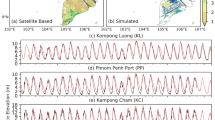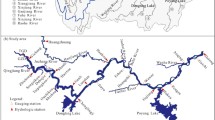Abstract
Natural variability in water flow is an inherent feature of river ecosystems, but many rivers in the world have been dammed, altering the flow regime and leading to ecosystem degradation. Dam reoperation to maintain environmental flows has been proposed for ecosystem and biodiversity improvement. Reoperation requires an understanding of flow alteration due to dam operations. However, knowledge of natural flow regimes and their degree of alteration remain poor in Japan. The Japanese islands extend from the sub-Arctic to the subtropics with four seasons and thus are considered to show high spatial and temporal variation in flow regime and alterations caused by those variations. We examined the spatial and temporal dependency of flow alteration by flood-control dams in Japan. We confirmed that flood-control dams reduced the rate of change in discharge and peak discharge and that such dams fulfilled their primary role of preventing flood disaster by reducing and delaying flooding. However, other flow characteristics, such as high- and low-flow frequency and duration, were also altered. We demonstrated that the magnitude, frequency, duration, and seasonality of high and low flows in undammed flow regimes differed with latitude and that discharge alteration was spatially and temporally dependent, presumably because dam operation responded to the inherent differences in seasonal flow variability at different latitudes.





Similar content being viewed by others
References
Acreman M, Arthington AH, Colloff MJ, Couch C, Crossman ND, Dyer F, Overton I, Pollino CA, Stewardson MJ, Young W (2014) Environmental flows for natural, hybrid, and novel riverine ecosystems in a changing world. Front Ecol Environ 12:466–473. doi:10.1890/130134
Allan JD, Castillo MM (2007) Stream ecology: structure and function of running waters, 2nd edn. Springer, The Netherlands
Arthington AH (2012) Environmental flows: saving rivers in the third millennium. University of California Press, Berkeley
Beesley L, King AJ, Amtstaetter F, Koehn JD, Gawne B, Price A, Nielsen DL, Vilizzi L, Meredith SN (2012) Does flooding affect spatiotemporal variation of fish assemblages in temperate floodplain wetlands? Freshw Biol 57:2230–2246. doi:10.1111/j.1365-2427.2012.02865.x
Bejarano MD, Marchamalo M, Garcia de Jalon D, Gonzalez del Tanago M (2010) Flow regime patterns and their controlling factors in the Ebro basin (Spain). J Hydrol 385:323–335. doi:10.1016/j.jhydrol.2010.03.001
Brauman KA, Daily GC, Duarte TK, Mooney HA (2007) The nature and value of ecosystem services: an overview highlighting hydrologic services. Annu Rev Env Resour 32:67–98
Colwell RK (1974) Predictability, constancy, and contingency of periodic phenomena. Ecology 55:1148–1153. doi:10.2307/1940366
Dingman SL (1978) Synthesis of flow-duration curves for unregulated streams in New-Hampshire. Water Resour Bull 14:1481–1502. doi:10.1111/j.1752-1688.1978.tb02298.x
Duffy WG, Kahara SN (2011) Wetland ecosystem services in California’s Central Valley and implications for the Wetland Reserve Program. Ecol Appl 21:S18–S30. doi:10.1890/09-1338.1
Fan M, Shibata H, Wang Q (2016) Optimal conservation planning of multiple hydrological ecosystem services under land use and climate changes in Teshio river watershed, northernmost of Japan. Ecol Indic 62:1–13. doi:10.1016/j.ecolind.2015.10.064
Gibbins C, Vericat D, Batalla RJ (2007) When is stream invertebrate drift catastrophic? The role of hydraulics and sediment transport in initiating drift during flood events. Freshw Biol 52:2369–2384. doi:10.1111/j.1365-2427.2007.01858.x
Gleick PH (2003) Water use. Annu Rev Environ Resour 28:275–314. doi:10.1146/annurev.energy.28.040202.122849
Honda N, Takahashi A, Kozima T (2011) Study on environmental improvement by flushing in Sagurigawa dam downstream (in Japanese). Eng Dams 303:46–52
Honey-Roses J, Acuna V, Bardina M, Brozovic N, Marce R, Munne A, Sabater S, Termes M, Valero F, Vega A, Schneider DW (2013) Examining the demand for ecosystem services: the value of stream restoration for drinking water treatment managers in the Llobregat River, Spain. Ecol Econ 90:196–205. doi:10.1016/j.ecolecon.2013.03.019
Iwasaki Y, Ryo M, Sui P, Yoshimura C (2012) Evaluating the relationship between basin-scale fish species richness and ecologically relevant flow characteristics in rivers worldwide. Freshw Biol 57:2173–2180. doi:10.1111/j.1365-2427.2012.02861.x
Japan Commission on Large Dams (2009) Dams in Japan: past, present and future. CRC Press/Balkema, The Netherlands
Japan Dam Association (2015) Dam yearbook. Japan Dam Association, Tokyo
Jowett IG, Biggs BJF (1997) Flood and velocity effects on periphyton and silt accumulation in two New Zealand rivers. NZ J Mar Freshw Res 31:287–300. doi:10.1080/00288330.1997.9516767
Kennard MJ, Pusey BJ, Olden JD, Mackay SJ, Stein JL, Marsh N (2010) Classification of natural flow regimes in Australia to support environmental flow management. Freshw Biol 55:171–193. doi:10.1111/j.1365-2427.2009.02307.x
Kobe T, Azami K, Osugi T, Urakami M, Itou H (2005) Improvement of river environment by flush discharge from the Miharu Dam (in Japanese). Ecol Civil Eng 8:15–34
Komatsu H, Kume T, Otsuki K (2010) A simple model to estimate monthly forest evapotranspiration in Japan from monthly temperature. Hydrol Process 24:1896–1911. doi:10.1002/hyp.7622
Kotsuki S, Tanaka K, Kojiri T (2013) Estimation of climate change impact on Japanese water resources: part 1 the development of a Japanese water resource model (in Japanese with English abstract). J Japan Soc Hydrol Water Resour 26:133–142
Kuzuha Y, Tomosugi K, Kishii T, Hayano M (2001) Classification of catchments by hydrologic regimes (in Japanese with English abstract). J Japan Soc Hydrol Water Resour 14:131–141
Ledger ME, Brown LE, Edwards FK, Milner AM, Woodward G (2012) Drought alters the structure and functioning of complex food webs. Nat Clim Change 3:223–227. doi:10.1038/nclimate1684
Lytle DA, Poff NL (2004) Adaptation to natural flow regimes. Trends Ecol Evol 19:94–100. doi:10.1016/j.tree.2003.10.002
Magilligan FJ, Nislow KH (2005) Changes in hydrologic regime by dams. Geomorphology 71:61–78. doi:10.1016/j.geomorph.2004.08.017
McCabe DJ, Gotelli NJ (2000) Effects of disturbance frequency, intensity, and area on assemblages of stream macroinvertebrates. Oecologia 124:270–279
Ministry of Land, Infrastructure, Transport and Tourism (2003) Idea for flexible management attempt for dam reservoirs (in Japanese). Available via DIALOG. http://www.mlit.go.jp/river/shishin_guideline/dam5/pdf/danryokukanri_tebiki.pdf of subordinate document. Accessed Apr 2003
Ministry of Land, Infrastructure, Transport and Tourism (2007) Idea for consideration of normal discharge from dam reservoirs (in Japanese). Available via DIALOG. http://www.mlit.go.jp/river/shishin_guideline/ryuuryoukentou/tebiki.pdf of subordinate document. Accessed Sep 2007
Miyao S, Takahashi Y, Andoh Y (1984) Estimation of discharge for flow regime classification using National Land Numerical Information in mountain streams (in Japanese). Water Sci 160:13–27
Mori T, Murakami M, Saitoh T (2010) Latitudinal gradients in stream invertebrate assemblages at a regional scale on Hokkaido Island, Japan. Freshw Biol 55:1520–1532. doi:10.1111/j.1365-2427.2009.02363.x
Natho S, Venohr M (2014) Active versus potential floodplains-the effect of small flood events on nutrient retention along the river Elbe corridor (Germany). Aquat Sci 76:633–642. doi:10.1007/s00027-014-0360-9
Nilsson C, Reidy CA, Dynesius M, Revenga C (2005) Fragmentation and flow regulation of the world’s large river systems. Science 308:405–408. doi:10.1126/science.1107887
Nilsson C, Jansson R, Malmqvist B, Naiman RJ (2007) Restoring riverine landscapes: the challenge of identifying priorities, reference states, and techniques. Ecol Soc 12
Oguchi S, Fujibe F (2012) Seasonal and regional features of long-term precipitation changes in Japan. Pap Meteorol Geophys 63:21–30
Oki T, Murakami M, Tanaka Y, Nakamura S, Maekawa M (2012) Water map in Japan (in Japanese). Asahi Shimbun Publications Inc., Tokyo
Olden JD, Poff NL (2003) Redundancy and the choice of hydrologic indices for characterizing streamflow regimes. Riv Res Appl 19:101–121. doi:10.1002/rra.700
Perkin JS, Gido KB, Cooper AR, Turner TF, Osborne MJ, Johnson ER, Mayes KB (2015) Fragmentation and dewatering transform Great Plains stream fish communities. Ecol Monogr 85:73–92. doi:10.1890/14-0121.1
Poff NL (1996) A hydrogeography of unregulated streams in the United States and an examination of scale-dependence in some hydrological descriptors. Freshw Biol 36:71–91. doi:10.1046/j.1365-2427.1996.00073.x
Poff NL, Ward JV (1989) Implications of streamflow variability and predictability for lotic community structure—a regional-analysis of streamflow patterns. Can J Fish Aquat Sci 46:1805–1818. doi:10.1139/F89-228
Poff NL, Allan JD, Bain MB, Karr JR, Prestegaard KL, Richter BD, Sparks RE, Stromberg JC (1997) The natural flow regime. Bioscience 47:769–784
Poff NL, Olden JD, Merritt DM, Pepin DM (2007) Homogenization of regional river dynamics by dams and global biodiversity implications. Proc Natl Acad Sci USA 104:5732–5737. doi:10.1073/pnas.0609812104
Postel S, Richter B (2003) Rivers for life: managing water for people and nature. Island Press, Washington, DC
Power ME, Dietrich WE, Finlay JC (1996) Dams and downstream aquatic biodiversity: potential food web consequences of hydrologic and geomorphic change. Environ Manag 20:887–895. doi:10.1007/BF01205969
R Development Core Team (2014) R: a language and environment for statistical computing. Vienna: R Foundation for Statistical Computing. (http://www.R-project.org)
Richter BD, Thomas GA (2007) Restoring environmental flows by modifying dam operations. Ecol Soc 12
Richter BD, Baumgartner JV, Powell J, Braun DP (1996) A method for assessing hydrologic alteration within ecosystems. Conserv Biol 10:1163–1174. doi:10.1046/j.1523-1739.1996.10041163.x
Richter BD, Mathews R, Wigington R (2003) Ecologically sustainable water management: managing river flows for ecological integrity. Ecol Appl 13:206–224. doi:10.1890/1051-0761(2003)013[0206:eswmmr]2.0.co;2
Sato T, Imada Y, Kanae S (2012) The change in frequency of extreme daily precipitation events associated with tropical cyclones in Asia-Pacific (in Japanese with English abstract). J Jpn Soc Civil Eng, Ser B1 68:I_1393–I_1398
Sekiguchi T (1959) Climatic classification of Japan (in Japanese with English abstract). Tokyo Geog Pap 3:65–78
Singer MB (2007) The influence of major dams on hydrology through the drainage network of the Sacramento River basin, California. Riv Res Appl 23:55–72. doi:10.1002/rra.968
Slutzman JE, Smith JA (2006) Effects of flood control structures on flood response for Hurricane Floyd in the Brandywine Creek watershed, Pennsylvania. J Hydrol Eng 11:432–441. doi:10.1061/(asce)1084-0699(2006)11:5(432)
Snelder TH, Lamouroux N, Leathwick JR, Pella H, Sauquet E, Shankar U (2009) Predictive mapping of the natural flow regimes of France. J Hydrol 373:57–67. doi:10.1016/j.jhydrol.2009.04.011
Tachikawa Y, Takino S, Fujioka Y, Yorozu K, Kim S, Shiba M (2011) Projection of river discharge of Japanese river basins under a climate change scenario (in Japanese with English abstract). J Jpn Soc Civil Eng, Ser B1 67:1–15
Todd CR, Ryan T, Nicol SJ, Bearlin AR (2005) The impact of cold water releases on the critical period of post-spawning survival and its implications for Murray cod (Maccullochella peelii peelii): a case study of the Mitta Mitta River, southeastern Australia. Riv Res Appl 21:1035–1052. doi:10.1002/rra.873
Vörösmarty CJ, McIntyre PB, Gessner MO, Dudgeon D, Prusevich A, Green P, Glidden S, Bunn SE, Sullivan CA, Liermann CR, Davies PM (2010) Global threats to human water security and river biodiversity. Nature 467:555–561. doi:10.1038/nature09440
Walters AW, Post DM (2011) How low can you go? Impacts of a low-flow disturbance on aquatic insect communities. Ecol Appl 21:163–174. doi:10.1890/09-2323.1
Watanabe Y, Hasegawa K (2004) Flood disaster at Hidaka district of Hokkaido due to the typhoon No.0301 (in Japanese). B Nat Disaster Sci Data Center, Hokkaido 18:13–22
Water Resources Environment Technology Center (2000) Practice for Dam Management (in Japanese). Kowa, Tokyo
World Commission on Dams (2000) Dams and development: a new framework for decision-making. Earthscan, London
Yoshimura C, Omura T, Furumai H, Tockner K (2005) Present state of rivers and streams in Japan. Riv Res Appl 21:93–112. doi:10.1002/rra.835
Yoshino M (1981) Climate classification in Japan (in Japanese). Disaster Res 12:39–59
Yuzukihara Y, Kiyosawa M, Osugi T, Takahashi Z (2012) Research on environmental released toward the river environment improvement of the dam downstream (in Japanese). Rep Water Resour Environ Res Inst 36–41
Acknowledgements
We thank Yasumitsu Kato and Yuki Fukuda of the Aqua Restoration Research Center for help with field and laboratory studies and the staff of the Aqua Restoration Research Center for logistics support. This study was supported by the Japan Society for the Promotion of Science (24710039, 14J09569).
Author information
Authors and Affiliations
Corresponding author
Additional information
Handling Editor: Jeremy J. Piggott.
Electronic supplementary material
Below is the link to the electronic supplementary material.
Rights and permissions
About this article
Cite this article
Mori, T., Onoda, Y. & Kayaba, Y. Geographical patterns of flow-regime alteration by flood-control dams in Japan. Limnology 19, 53–67 (2018). https://doi.org/10.1007/s10201-017-0518-y
Received:
Accepted:
Published:
Issue Date:
DOI: https://doi.org/10.1007/s10201-017-0518-y




